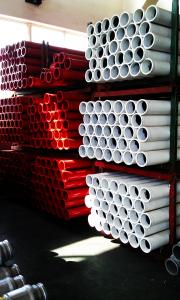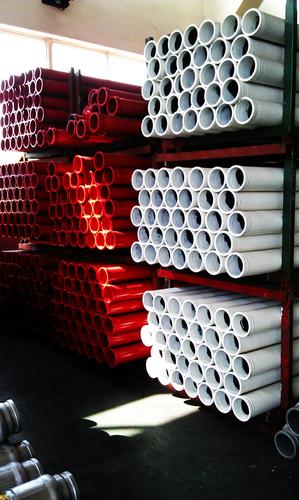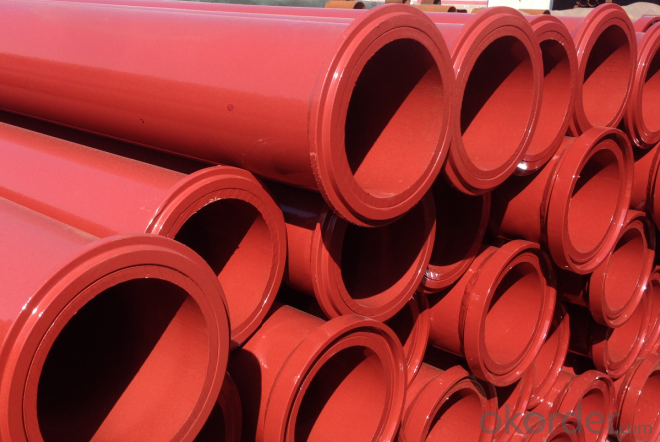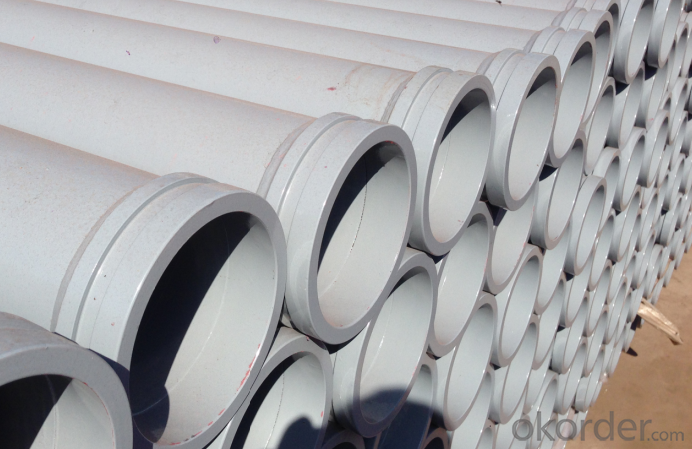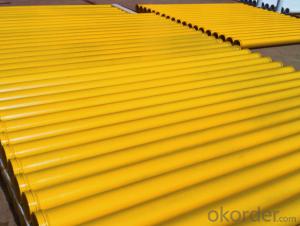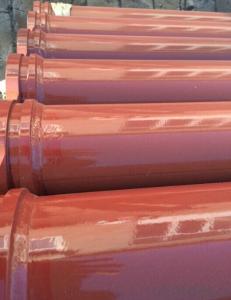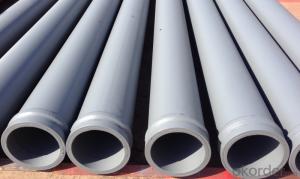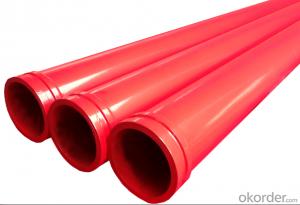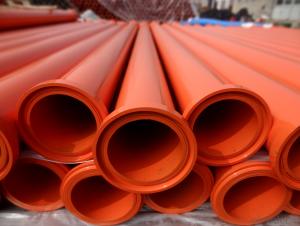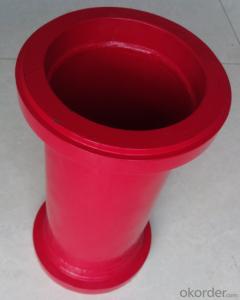Concrete Pump Parts Steel Pipe Delivery Pipe ST52 DN125
- Loading Port:
- Tianjin
- Payment Terms:
- TT OR LC
- Min Order Qty:
- 256 pc
- Supply Capability:
- 10000 pc/month
OKorder Service Pledge
OKorder Financial Service
You Might Also Like
Product Description:
Used for concrete transportation in construction work
Our concrete pump pipes have been successfully exported to many countries from 1998, Our main markets as below: Middle East, Southeast Asia, America, Brazil, Italy, Russia, South Africa etc.
Main Product Features:
Application
Used for concrete transportation in construction work
Length
1m-6m or according to the customer's requirement
Material
ST52
Thickness
4.0mm/4.2mm/4.5mm/5mm/5.2mm/5.5mm.ect.
Weight
38KG/40KG/43KG/48KG/52KG
Color
as clients required
Using life
12.000m³/15.000m³/25.000m³/35.000m³/50.000m³
Collar
148 or 157mmTwin wall flange
Feature
High Wear-resistant , long service life , lower cost
Product Specifications:
Dimension: DN125
Length: 2m
Thickness: 4.1mm
Material: ST52
Characteristics: double-ends flange
Package: Seaworthy packing or as customers’ request.
FAQ:
Q1: How to confirm that your pipes could be used in our pump?
A1: We have been providing parts for nearly ten years, and cooperating with the agent of the world famous brand, possess near every kind of pipe in the market. What is more, we can produce as the customers’ request with drawing provided.
Q2: How do we guarantee the quality of our products?
A2: We have established an advanced quality management system which conducts strict quality tests at every step, from raw materials to the final product.
Q3: How soon can we receive the product after purchase?
A3: Within three days of placing an order, we will begin production. The specific shipping date is dependent upon international and government factors, but is typically 5-15 workdays.
Q4: If we can produce some Concrete Pump Truck Parts according to customers request?
A4: Yes, we can produce Concrete Pump Truck Parts according to the difference country situations to make it suitable to the market and customers. We have very professional technical team to make the design.
Q5: How to make a quick resolution for after service?
A5: OKorder and our manufacture both have overseas branches all-around of world, IF needed, the seller shall dispatch 2 engineers to the buyer's site for supervision of training. The buyer shall make available of necessary facilities & skilled personnel at site for training.
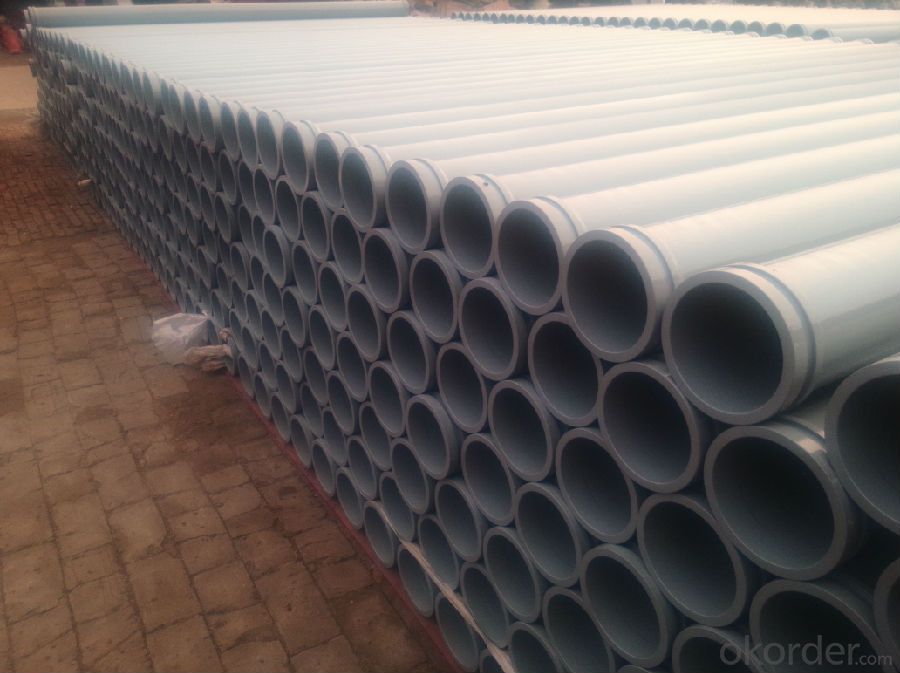
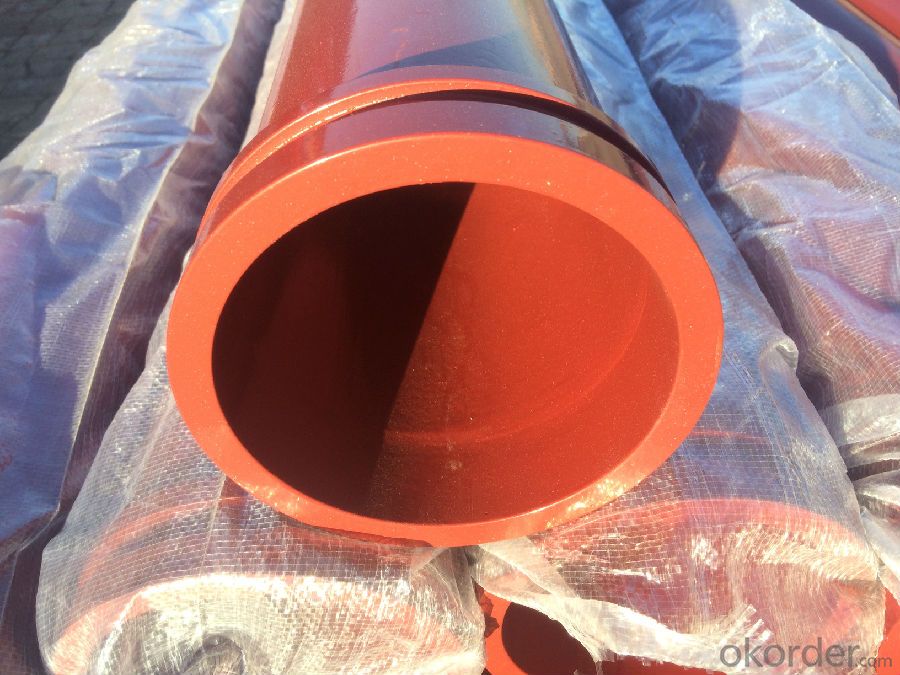
- Q: What are the signs of wear and tear in concrete pump spare parts?
- Some signs of wear and tear in concrete pump spare parts include cracks or fractures in the components, excessive vibration or noise during operation, decreased performance or efficiency, leaks or drips from seals or connectors, and visible corrosion or rust on metal parts. Additionally, worn-out or damaged rubber gaskets, seals, or O-rings can also indicate the need for replacement.
- Q: How can one ensure proper documentation and record-keeping for concrete pump spare parts?
- To guarantee the appropriate documentation and record-keeping for concrete pump spare parts, one can take several measures: 1. Establishing a systematic inventory management system: A well-organized inventory management system should be implemented to track all spare parts effectively. Each part should be assigned unique codes or identification numbers, and a comprehensive inventory list should be maintained. 2. Maintaining accurate records: Detailed records should be created for each spare part, including its description, quantity, purchase date, supplier information, and cost. It is crucial to update this information regularly and make it easily accessible. 3. Implementing a standardized labeling system: Clear and consistent labels should be used on all spare parts to facilitate easy identification and location. This will minimize confusion and prevent misplacement. 4. Storing spare parts in a designated area: A specific storage area should be designated for spare parts, preferably a well-organized warehouse with proper shelving and sufficient space. This ensures secure and convenient storage. 5. Implementing a maintenance and repair schedule: A maintenance and repair schedule should be developed for the concrete pump and its spare parts. Regular inspections of all parts should be conducted, and any repairs or replacements should be documented and reflected in the inventory. 6. Training staff on documentation procedures: Employees responsible for managing spare parts should receive training on proper documentation procedures. This includes accurate recording, labeling, and updating of inventory records. 7. Performing periodic stock checks: Regular stock checks should be carried out to verify the accuracy of inventory records and identify any discrepancies. This helps identify missing or misplaced spare parts and ensures up-to-date documentation. 8. Implementing an integrated software system: An inventory management software system specifically designed for this purpose should be utilized. These systems automate documentation, track stock levels, and generate reports, enhancing efficiency and accuracy. By adhering to these measures, one can ensure proper documentation and record-keeping for concrete pump spare parts, reducing the risk of errors, improving efficiency, and guaranteeing the availability of the right spare parts when needed.
- Q: How can one differentiate between genuine and counterfeit concrete pump spare parts?
- Differentiating between genuine and counterfeit concrete pump spare parts can pose a challenge, but there are several methods to ensure the authenticity of your purchase. Consider the following strategies: 1. Manufacturer Research: Begin by thoroughly researching the manufacturer of the concrete pump spare parts. Look for reputable, well-established companies with a proven track record. Analyze their industry standing, read customer reviews, and examine their website. Genuine manufacturers typically have a strong online presence and provide detailed product information. 2. Supplier Verification: When purchasing spare parts, it is crucial to select a reliable and authorized supplier. Ensure the supplier has a good reputation in the industry and a long-standing presence. Authorized distributors often have direct relationships with manufacturers and can provide authentic parts. 3. Inspection of Product Packaging: Genuine concrete pump spare parts typically have specific packaging that includes branding, logos, and detailed product information. Counterfeit products may have inferior packaging quality, misspellings, incorrect logos, or inconsistent color schemes. Carefully examine the packaging to determine its authenticity. 4. Evaluation of Product Quality and Finish: Counterfeit parts are often made from low-quality materials and lack the precision and finish of genuine parts. Inspect the spare parts for signs of poor workmanship, rough edges, or uneven surfaces. Genuine parts are typically well-crafted and undergo strict quality control measures. 5. Price Comparison: Exercise caution when encountering significantly lower prices for spare parts, as this may indicate counterfeit products. Counterfeiters often sell their goods at lower prices to attract customers, but the quality and performance may be compromised. Compare prices with other suppliers to ensure they fall within the expected range. 6. Seek Expert Advice: If you are unsure about the authenticity of concrete pump spare parts, consult industry experts or experienced professionals. They can assist you in identifying genuine components and making informed decisions. 7. Request Certifications and Documentation: Genuine manufacturers provide certifications and documentation, such as ISO certifications or test reports, to validate the quality and authenticity of their products. Ask the supplier for these documents and verify their legitimacy with the manufacturer if necessary. Remember, purchasing genuine concrete pump spare parts is crucial for the safety and efficiency of your equipment. By following these steps and exercising caution, you can minimize the risk of purchasing counterfeit components and ensure the longevity and reliable performance of your concrete pump.
- Q: What are the signs of a malfunctioning concrete pump control valve?
- Some signs of a malfunctioning concrete pump control valve may include erratic or inconsistent flow of concrete, difficulty in controlling the pump speed, leaking or dripping of hydraulic fluid, unusual noises or vibrations coming from the valve, and unresponsive or delayed response to control inputs.
- Q: How can a faulty boom affect the concrete placement process?
- A faulty boom can significantly affect the concrete placement process. It can lead to uneven distribution of concrete, resulting in inconsistent concrete strength and quality. It may also cause the concrete to be placed in unintended areas or at incorrect heights, affecting the overall structural integrity of the project. Additionally, a faulty boom can pose a safety risk to workers and equipment involved in the concrete placement process.
- Q: Can concrete pump spare parts be purchased online?
- Indeed, online purchases of concrete pump spare parts are possible. Numerous online platforms and websites cater specifically to the sale of construction equipment and spare parts, including those for concrete pumps. These digital stores present a comprehensive assortment of options and brands, enabling customers to peruse and choose the precise spare parts required for their concrete pump. Moreover, online buying grants the convenience of price comparison, perusal of customer reviews, and doorstep delivery of the spare parts. Nevertheless, it remains imperative to ascertain the authenticity and dependability of the online store prior to making a purchase, guaranteeing the acquisition of genuine and top-notch spare parts.
- Q: What is the purpose of a concrete pump cylinder?
- The primary aim of a concrete pump cylinder is to generate the required pressure and force for the transportation and delivery of concrete to a desired location. It serves as a vital element within a concrete pump, facilitating the smooth and productive movement of concrete throughout the pump system. The cylinder operates by utilizing hydraulic pressure to propel the concrete through the pipeline, guaranteeing a continuous and seamless flow. Its significance lies in its contribution to construction projects, enabling accurate and efficient placement of concrete in diverse settings such as buildings, bridges, and other structures. By supplying the necessary power and pressure, the concrete pump cylinder ensures effortless and labor-saving transportation of concrete over long distances, both vertically and horizontally. Ultimately, its purpose revolves around enhancing the efficiency and precision of concrete delivery, thereby saving time and effort in construction endeavors.
- Q: How can one ensure proper alignment and positioning of concrete pump spare parts during installation?
- Ensuring proper alignment and positioning of concrete pump spare parts during installation is crucial for the efficient and safe operation of the pump. Here are some key steps to follow to achieve the desired alignment and positioning: 1. Thoroughly read and understand the manufacturer's instructions: Before starting the installation process, carefully go through the manufacturer's instructions and guidelines. This will provide you with important information on the correct alignment and positioning of the spare parts specific to your concrete pump model. 2. Prepare a suitable work area: Clear the work area of any debris, dust, or obstacles that might hinder the installation process. Ensuring a clean and organized work environment will make it easier to position and align the spare parts accurately. 3. Utilize proper lifting equipment: Concrete pump spare parts can be heavy and require special lifting equipment to avoid damage or injuries. Use cranes, hoists, or forklifts to lift and position the spare parts accurately and safely. 4. Use precision measuring tools: Invest in high-quality measuring tools, such as laser levels, alignment guides, and precision measuring tapes. These tools will help you ensure precise alignment and positioning of the spare parts during installation. 5. Double-check dimensions and specifications: Before installing any spare part, cross-check the dimensions and specifications provided by the manufacturer with the actual part. This will help you identify any discrepancies or potential issues that need to be addressed before installation. 6. Follow a systematic installation process: Start with the main components of the concrete pump and gradually work your way towards the spare parts. Follow a step-by-step approach, aligning and positioning each spare part meticulously according to the manufacturer's instructions. 7. Seek professional assistance if needed: If you are unsure about the proper alignment and positioning of certain spare parts, do not hesitate to seek professional assistance. Consulting with experienced technicians or contacting the manufacturer's customer support can provide valuable guidance and ensure correct installation. 8. Conduct a final inspection: Once all the spare parts are installed, conduct a thorough inspection to verify the alignment and positioning. Check for any visible gaps, misalignments, or irregularities. Rectify any issues immediately to ensure proper function and longevity of the concrete pump. By following these steps and paying attention to detail, you can ensure the proper alignment and positioning of concrete pump spare parts during installation, resulting in a reliable and efficient pump system.
- Q: How can a faulty concrete pump control valve affect the pumping operation?
- A faulty concrete pump control valve can have several negative effects on the pumping operation. Firstly, it can cause a loss of control over the concrete flow rate. The control valve is responsible for regulating the amount of concrete being pumped, and if it is faulty, it may not be able to properly adjust the flow rate. This can lead to either too much or too little concrete being pumped, which can result in an inefficient operation. Secondly, a faulty control valve can cause inconsistent concrete flow. The valve is designed to maintain a steady and consistent flow of concrete, but if it is not functioning properly, it may result in fluctuations in the flow. This can lead to uneven distribution of the concrete, which can affect the quality and integrity of the pumped concrete. Furthermore, a faulty control valve can also contribute to increased wear and tear on the pump and other components. When the valve is not operating correctly, it can cause excessive pressure or strain on the pump, leading to increased wear on the equipment. This can result in more frequent breakdowns or the need for repairs, which can be costly and time-consuming. Overall, a faulty concrete pump control valve can significantly impact the pumping operation by causing a loss of control over the flow rate, inconsistent concrete flow, and increased wear and tear on the equipment. It is important to regularly inspect and maintain the control valve to ensure its proper functioning and avoid these negative consequences.
- Q: What is the role of a concrete pump hopper vibrator?
- The role of a concrete pump hopper vibrator is to ensure the smooth and efficient flow of concrete from the hopper into the pump. It helps to prevent clogging and blockages by vibrating the hopper, which loosens the concrete and allows it to flow freely into the pump.
Send your message to us
Concrete Pump Parts Steel Pipe Delivery Pipe ST52 DN125
- Loading Port:
- Tianjin
- Payment Terms:
- TT OR LC
- Min Order Qty:
- 256 pc
- Supply Capability:
- 10000 pc/month
OKorder Service Pledge
OKorder Financial Service
Similar products
Hot products
Hot Searches
Related keywords
